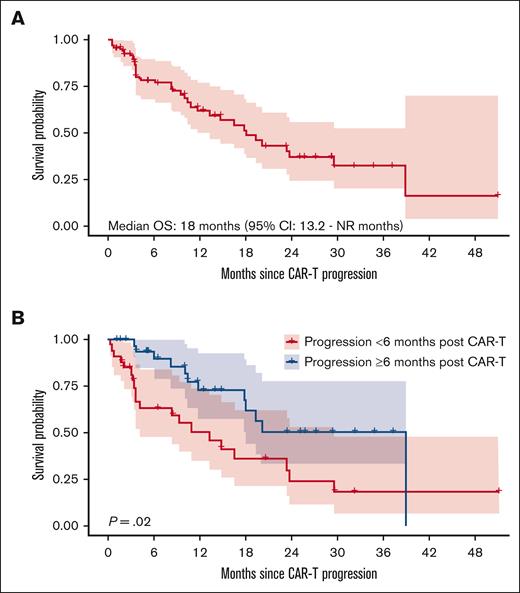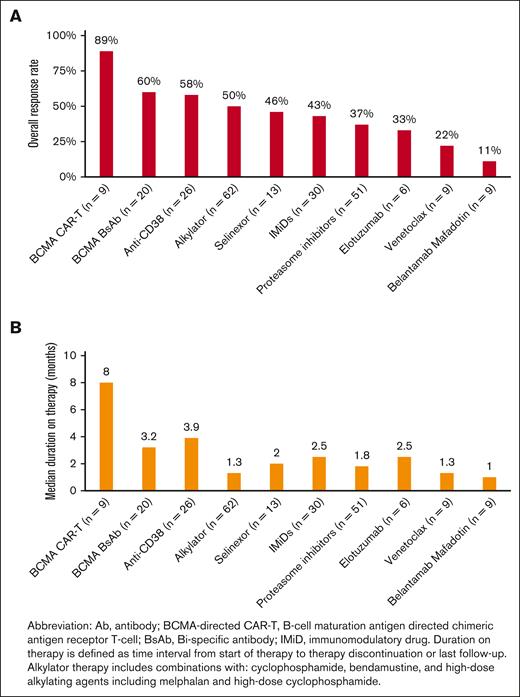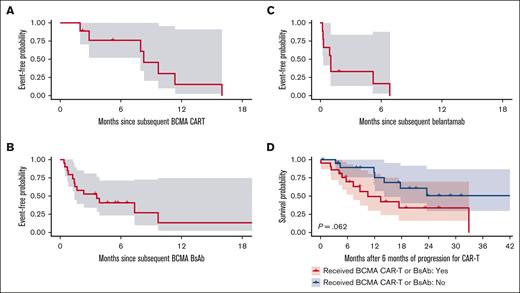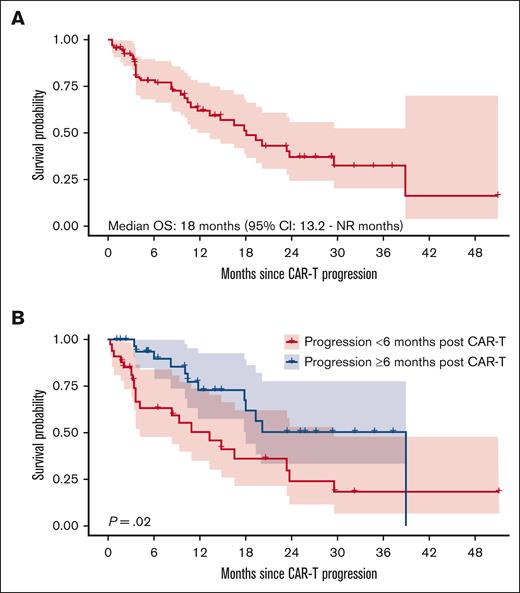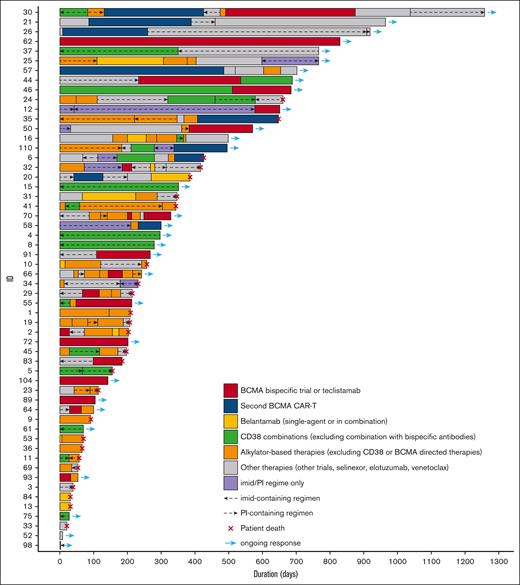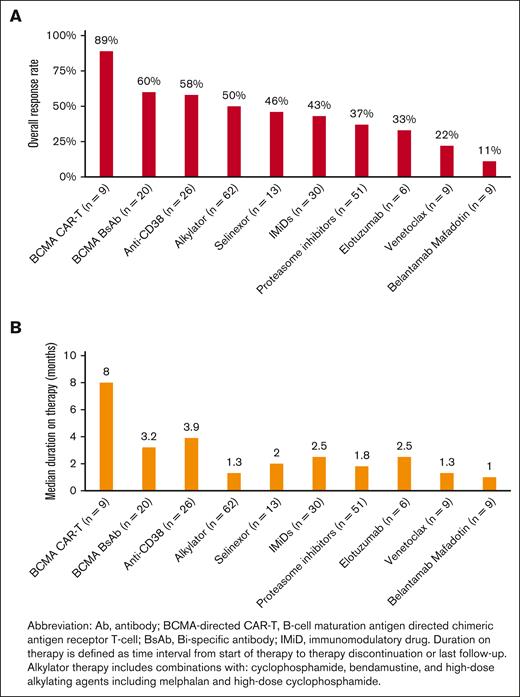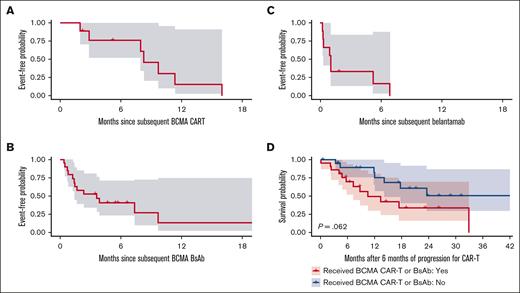Retreatment with BCMA-directed therapies after prior BCMA-directed CAR-T can elicit high response rates in patients with multiple myeloma.
Despite high response rates, durability of responses to salvage therapies after BCMA-directed CAR-T relapses are currently suboptimal.
Visual Abstract
For patients with relapsed/refractory multiple myeloma with a relapse after B-cell maturation antigen (BCMA)–directed chimeric antigen receptor T-cell therapy (CAR-T), optimal salvage treatment strategies remain unclear. BCMA-directed CAR-T and bispecific antibodies (BsAbs) are now commercially available, and the outcomes for retreatment with BCMA-directed approaches are not well studied. We performed a retrospective analysis of 68 patients with relapsed disease after BCMA-directed CAR-T to evaluate outcomes and responses to salvage therapies. With a median follow-up of 13.5 months, median overall survival from time of relapse until death was 18 months (95% confidence interval [CI], 13.2 to not reached [NR]). Fifty-eight patients received subsequent myeloma-directed therapies, with a total of 265 lines of therapy (LOTs). The overall response rate for firstline salvage therapy was 41% (95% CI, 28-55). Among all LOTs, high response rates were observed among those receiving another BCMA-directed CAR-T (89%), BCMA-directed BsAbs (60%), CD38-directed combinations (80% when combined with BsAb; 50% when combined with immunomodulatory drugs and/or proteasome inhibitors), and alkylator-combinations (50% overall; 69% with high-dose alkylators). Thirty-four patients received at least 1 line of salvage BCMA-directed therapy; median progression-free survival was 8.3 months (95% CI, 7.9 to NR), 3.6 months (95% CI, 1.4 to NR), and 1 month (95% CI, 0.9 to NR) with median duration of response (DOR) of 8 months, 4.4 months, and 2.8 months for subsequent BCMA-directed CAR-T, BsAb, and belantamab mafadotin, respectively. Retreatment with BCMA-directed CAR-T and BsAbs can be effective salvage options after BCMA-directed CAR-T relapse; however, DORs appear limited, and further studies with new combinations and alternative targets are warranted.
Introduction
The advent of B-cell maturation antigen (BCMA)–directed chimeric antigen receptor T-cell therapy (CAR-T) has demonstrated significant promise and clinical efficacy in the treatment of patients with relapsed/refractory multiple myeloma (R/R MM), leading to deep remissions and overall advancing the antimyeloma therapy landscape.1 These findings led to the US Food and Drug Administration (FDA) approval of 2 BCMA-directed CAR-T, idecabtagene vicleucel (ide-cel) and ciltacabtagene autoleucel (cilta-cel), in patients with triple-class–exposed R/R MM after ≥4 prior lines of therapy (LOTs).2,3 Although high response rates and deep remissions can be achieved, relapse after these therapies are commonly observed. Currently, there is limited knowledge on the outcomes and optimal management of patients with R/R MM who develop progressive disease (PD) after BCMA-directed CAR-T. Previous studies have shown low overall response rates (ORRs) and short response durations to subsequent salvage therapy for this patient population.4,5 Given the recent FDA approvals of BCMA-directed bispecific antibodies (BsAbs), including teclistamab and elranatamab, alongside the gradual increase in availability of commercial BCMA-directed CAR-T slots, retreatment with BCMA-targeted agents may be a possible treatment strategy. At this time, data on the efficacy of subsequent BCMA-directed therapies after BCMA-directed CAR-Ts are limited. In this study, we analyzed patients with R/R MM at our institution treated with BCMA-directed CAR-Ts and specifically investigated the clinical outcomes after CAR-T relapse and the efficacy of salvage therapies, including the reuse of BCMA-directed therapies.
Methods
We retrospectively reviewed all patients with R/R MM treated with BCMA-directed CAR-T at the University of California San Francisco between 13 November 2017 and 17 October 2022. The last follow-up date cutoff was 5 July 2023. All patients included in this analysis had R/R MM and were treated with BCMA-directed CAR-T, either on clinical trial or as part of standard of care with commercial ide-cel or cilta-cel. Patients with PD after BCMA-directed CAR-T as defined by the International Myeloma Working Group response criteria were included in the study cohort.6-8
Demographics, baseline disease characteristics, BCMA-directed CAR-T characteristics, and pre– and post–CAR-T treatment regimen(s) were retrospectively collected. BCMA-directed CAR-T responses as well as data on clinical outcomes for post-CAR-T salvage therapies, including response rates and duration on therapy, were also analyzed. Responses to salvage treatments were assessed according to International Myeloma Working Group criteria, and durations on treatment were collected as defined by the time from treatment initiation to the time of next LOT, death, or last-follow-up, whichever occurred first. Among the patients receiving salvage BCMA-directed therapies, additional analysis was conducted to assess progression-free survival (PFS) and duration of response (DOR), defined as the time from start of salvage BCMA-directed therapy until PD or death for PFS and the time from response to salvage BCMA-directed therapy until PD, death, or last follow-up. Triple-class refractoriness was identified and defined as being refractory to ≥1 immunomodulatory drug, ≥1 proteasome inhibitor (PI), and ≥1 anti-CD38 monoclonal Ab. Penta-refractoriness was also identified and defined as being refractory to ≥2 immunomodulatory drugs, ≥2 PIs, and ≥1 anti-CD38 monoclonal Ab. High-risk fluorescent in situ hybridization results were defined by the presence of a gain or amplification of chromosome 1q21, del17p, t(4;14), t(14;16), and/or t(14;20).9 Descriptive statistics, such as proportions, medians, and ranges, were used to summarize demographic and outcome variables, as appropriate. Overall survival (OS) and PFS were summarized using Kaplan-Meier method and compared between patient groups using log-rank tests. All statistical analyses were performed using R version 4.2.1 with P value <.05 as a threshold for statistical significance. The study was approved by the University of California San Francisco Institutional Review Board and was conducted in accordance with the principles of the Declaration of Helsinki.
Results:
A total of 113 patients with R/R MM were treated with BCMA-directed CAR-Ts, with baseline characteristics and outcomes summarized in supplemental Table 1 and supplemental Figure 1, respectively. At the time of analysis, 68 patients had developed PD after CAR-T, including 58 patients who started next-line therapy, 5 patients who died before next-line therapy started, and 5 patients with PD who had not yet started next-line therapy. The baseline characteristics of this cohort at the time of CAR-T initiation and the treatment responses to CAR-T are summarized in Table 1. Seventeen patients (25%) received commercial ide-cel, 3 patients (4%) received commercial cilta-cel, and 48 patients (71%) received BCMA-directed CAR-T on clinical trial, including 30 of these patients (44%) receiving products on trial at recommended phase 2 dose (RP2D). Sixty-five patients met the criteria for biochemical PD, and 32 patients had evidence of clinical relapse, including the development of new or definite increase in the size of existing plasmacytomas or bone lesions. The median OS from the time of PD after CAR-T until death was 18 months (95% confidence interval [CI], 13.2 to not reached [NR]), with a median follow-up of 10 months (range, 0.4-51; Figure 1A). Patients who had PD within 6 months after CAR-T infusion had inferior OS compared with those who relapsed later (median, 13.2 vs 38.9 months; P = .02; Figure 1B).
Overall survival curves post-CAR-T relapse. (A) OS after initial BCMA-directed CAR-T relapse. (B) OS stratified by disease progression <6 months or ≥6 months after initial BCMA-directed CAR-T.
Overall survival curves post-CAR-T relapse. (A) OS after initial BCMA-directed CAR-T relapse. (B) OS stratified by disease progression <6 months or ≥6 months after initial BCMA-directed CAR-T.
Among the 58 patients who started next-line therapy after CAR-T relapse, a total of 265 LOTs were initiated after CAR-T relapse with a median of 2 salvage LOTs (range, 1-8) per patient after CAR-T relapse. The ORR for firstline salvage therapy was 41% (95% CI, 28-55). The most commonly used strategies as firstline salvage included: alkylator-containing therapy (n = 13), CD38-based combination therapy (n = 11), and alternative BCMA-directed treatment (n = 11; including 6 BsAb, 4 belantamab mafadotin, and 1 CAR-T). The median duration on firstline salvage treatment was 2.2 months.
To better assess the efficacy of salvage therapies after CAR-T relapse, all LOTs were assessed with treatment courses illustrated in Figure 2 for each patient. ORR and median duration on therapy for each type of salvage antimyeloma treatment class after BCMA-directed CAR-T relapse is depicted in Figure 3. Thirty-four patients received at least 1 line of salvage BCMA-directed therapy (CAR-T, BsAb therapy, or belantamab mafodotin) after relapse on BCMA-directed CAR-T (Table 2); a total of 38 LOTs were administered among these patients including 20 LOTs with BCMA-directed BsAb, 9 LOTS with subsequent BCMA-directed CAR-T, and 9 LOTs with belantamab mafadotin. Among the 9 patients receiving subsequent BCMA-directed CAR-T, 2 patients received cilta-cel, 1 patient received ide-cel, and the remaining 6 patients received subsequent CAR-T on study; all but 1 patient received a different BCMA-directed CAR-T from their original BCMA-directed CAR-T. The ORR for salvage BCMA-directed therapies at any point after BCMA-directed CAR-T relapse was 55% (21 responses in 38 LOTs); this included an ORR of 89%, 60%, and 11% for subsequent BCMA-directed CAR-T, BCMA-directed BsAb, and belantamab mafadotin, respectively. The median time from initial BCMA-directed CAR-T to subsequent BCMA-directed CAR-T, BCMA-directed BsAb, and belantamab mafadotin was 23.8, 13.7, and 14.5 months, with a range of 8.2 to 32.2, 2.5 to 38.4, and 1 to 20.8 months for subsequent BCMA-directed CAR-T, BCMA-directed BsAb, and belantamab mafadotin, respectively. Notably, among the 9 patients who did not achieve a very good partial response or better with the original BCMA-directed CAR-T, 6 (67%) were able to subsequently achieve a very good partial response or better with salvage BCMA-directed therapies after CAR-T relapse. Median PFS was 8.3 months (95% CI, 7.9 to NR), 3.6 months (95% CI, 1.4 to NR), and 1 month (95% CI, 0.9 to NR) for subsequent BCMA-directed CAR-T, BsAb, and belantamab mafadotin, respectively (Figure 4A-C), with median DOR of 8 months (range, 0.5-15.5), 4.4 months (range, 1-26.5), and 2.8 months (for the 1 responder) for subsequent BCMA-directed CAR-T, BsAb, and belantamab mafadotin, respectively. In a landmark analysis, patients who received either a salvage BCMA-directed CAR-T or BCMA-directed BsAbs within 6 months of disease relapse had a trend toward improved OS compared with those who did not receive BCMA-directed CAR-T or BsAbs within 6 months of disease relapse (median OS after CAR-T relapse, NR vs 16.5 months; P = .06; Figure 4D).
ORRs and median duration on therapy of subsequent salvage treatments after BCMA-directed CAR-T relapse.
ORRs and median duration on therapy of subsequent salvage treatments after BCMA-directed CAR-T relapse.
Progression-free survival curves with BCMA retreatment. (A-C) PFS curves for subsequent BCMA-directed CAR-T (A), BCMA-directed BsAb (B), and belantamab mafadotin (C). (D) OS stratified by the receipt of subsequent BCMA-directed CAR-T or BsAb within 6 months of progression from original CAR-T.
Progression-free survival curves with BCMA retreatment. (A-C) PFS curves for subsequent BCMA-directed CAR-T (A), BCMA-directed BsAb (B), and belantamab mafadotin (C). (D) OS stratified by the receipt of subsequent BCMA-directed CAR-T or BsAb within 6 months of progression from original CAR-T.
To determine whether patients who relapsed early or later responded differently to subsequent salvage BCMA-directed therapies, patients were stratified according to those who relapsed <6 months (early relapse; n = 33 patients) and those who relapsed after 6 months (later relapse; n = 35 patients) after CAR-T infusion. The proportion of patients with early relapse and those with later relapse receiving initial BCMA-directed CAR-T at RP2D or greater was similar (73% vs 71%; P = .9). There were 14 patients with early relapse and 20 patients with later relapse treated with subsequent BCMA-directed therapies. Among patients treated with salvage BCMA-directed CAR-T, all 4 patients with early relapse responded (ORR, 100%), and 4 of 5 patients with later relapse responded (ORR, 80%). Among those patients treated with subsequent BCMA-directed BsAb, 7 of 9 patients with early relapse responded (ORR, 78%), and 5 of 11 with later relapse responded (ORR, 45%). There were no responders among 4 patients with early relapse (ORR, 0%), and there was 1 responder among the 5 patients with later relapse (ORR, 20%) treated with belantamab mafadotin.
Other plasma cell–directed therapies were also able to elicit hematologic responses. Anti-CD38 Ab combinations had an ORR of 58% (15 responses in 26 LOTs), with a median duration on therapy of 3.9 months (range, 0-17). When stratified by combination type, anti-CD38 Ab combinations with conventional immunomodulatory drugs (IMIDs) and/or PIs had an ORR of 44% (7 responses in 16 LOTs), and CD38 Ab combinations with BsAb (on clinical trial) had an ORR of 80% (4 responses in 5 LOTs), with responders on traditional CD38 Ab with IMIDS/PIs having a median duration on therapy of 2.5 months (range, 0-11.8) and responders in the CD38 Ab/BsAb combination having a median duration on therapy of 12.9 months (range, 5.4-16.8). Alkylator-based therapies were also effective with an ORR of 50% (31 responses in 62 LOTs); this included 32 LOTs using high-dose chemotherapy (26 LOTs using high-dose cyclophosphamide with dexamethasone [HyperCd], 2 LOTs using HyperCd and doxorubicin, 1 LOT with cisplatin-doxorubicin-cyclophosphamide-etoposide, and 3 LOTs with salvage high-dose melphalan with autologous stem cell transplant), resulting in an ORR of 69% (22 responses in 32 LOTs). The dose and schedule of HyperCd was per provider discretion, generally adjusted based on renal function, with cyclophosphamide dosing ranging from 350 mg/m2 every 12 hours for 6 to 8 doses to 500 mg/m2 every 24 hours for 3 doses with mesna support and pulse dexamethasone 20 to 40 mg daily for 4 days, given 1 to 3 times per 28-day cycle.10
Other therapy classes had ORRs ranging from 11% to 50%, with median duration on therapy generally lasting <3 months.
Discussion
The overall treatment landscape for R/R MM is continuing to evolve, and currently, BCMA-directed CAR-T are some of the most active agents to treat R/R disease.2,3,11 However, unlike in the treatment of diffuse large B-cell lymphoma, in which a subset of patients may be cured with CAR-T, the majority of patients with R/R MM treated with BCMA-directed CAR-T ultimately develop PD despite achieving deep responses to therapy. We observed that for patients who developed relapsed disease after BCMA-directed CAR-T, OS was limited, with a median OS of 18 months after CAR-T relapse. Given these factors, determining the most effective salvage strategies after CAR-T relapses is paramount, and understanding this may eventually help to develop optimal therapy combinations and sequences to potentially improve survival and, hopefully, develop curative CAR-T approaches.
At time of data analysis, 68 of our 113 patients had developed PD after CAR-T. The majority of patients were able to start next-line therapy, and the ORR for firstline salvage therapy was 41%, similar to results previously reported.5 One of the most frequently used therapy at firstline salvage was CD38-based combination, likely due to accessibility and experience with using this class. Alkylator-based therapies were also commonly used, including bendamustine and high-dose cyclophosphamide, the latter especially for rapid PD. BCMA-directed approaches as firstline salvage were used in 11 patients, with belantamab mafadotin being used in earlier cohorts before its market withdrawal and teclistamab being used more recently after its FDA approval. Notably, the median duration of firstline therapy was short (<3 months), and most patients proceeded to receive subsequent LOTs.
We observed responses after CAR-T relapse to treatment classes that patients were deemed refractory to pre–CAR-T treatment. This included conventional therapies such as alkylators, iMIDs, PIs, and CD38 Abs, with response rates generally ranging from 20% to 50%. Similar to the results observed by Van Oeklen et al,5 high-dose alkylator-based therapies including with HyperCd and salvage melphalan-based autologous stem cell transplant demonstrated high ORRs (∼70%); however, DORs to these therapies were limited. Because these therapies are associated with significant toxicities, the use of high-dose alkylator therapy may be most appropriately used as a bridge to subsequent line therapy or as means to control rapid PD. We also observed that retreatment with CD38 Ab–based therapies could elicit a hematologic response in a fair proportion of patients; this appeared to be most effective when combined with BsAbs on trial. Ongoing trials are investigating the combination of CD38 Abs with both BCMA-directed BsAbs and other targeted BsAbs.12-14
Reasons for relapsed disease after BCMA-directed CAR-T remain an area of ongoing investigation. Although loss of BCMA has been described, 15-17 the majority of patients with relapsed disease after BCMA-directed CAR-T continue to have positive BCMA expression on MM cells, and other factors including CAR-T persistence, T-cell exhaustion, anti-CAR Abs, and the tumor microenvironment may be important determinants of disease relapse.18-20 Given that BCMA expression is still present in the majority of relapses,18 retreatment with BCMA-targeted therapies may be a feasible strategy after BCMA-directed CAR-T relapse. In the MajesTEC-1 trial, an ORR of 45% was observed for teclistamab in patients who had prior BCMA-directed CAR-T, with the observed baseline BCMA expression on relapse after CAR-T being comparable with that observed in patients naïve to BCMA treatment on the trial.21 Similar results were observed for elranatamab in a pooled analysis of the MagnetisMM studies.22 Although prior BCMA-directed CAR-T was excluded in the CARTITUDE-2 trial, the use of cilta-cel after previous noncellular BCMA-directed therapies led to an ORR 60% and PFS of 9.1 months, suggesting that subsequent BCMA-directed CAR-T after prior BCMA-directed therapies can be effective; however, data on treatment outcomes to a second BCMA-directed CAR-T after initial BCMA-directed CAR-T remain limited.23 Use of an alternative CAR-T construct after initial BCMA-directed CAR-T relapse may be important as well; in the KarMMa trial, anti–CAR-T Abs developed over time from 21% at 3 months to 65% at 12 months after treatment with ide-cel, with none of the 16 patients with anti–CAR-T Abs responding to ide-cel retreatment after relapse.24 In our cohort, 8 of the 9 patients receiving subsequent BCMA-directed CAR-T received a different CAR-T from their original CAR-T.
We observed high response rates for subsequent BCMA-directed CAR-T and BCMA-directed BsAbs, with an ORR of 89% and 60%, respectively, even among patients who did not achieve hematologic response with their initial BCMA-directed CAR-T. However, despite high response rates, the median PFS and DOR of those treated with subsequent BCMA-directed therapies after prior BCMA-directed CAR-T were limited and shorter than those typically observed in patients naïve to BCMA treatment. One mechanism recently described includes antigen escape (eg, loss of BCMA), which may depend on allelic composition before BCMA-directed CAR-T, with subsequent biallelic losses or BCMA extracellular domain mutations resulting in relapse from or resistance to BCMA-directed therapies.24 In contrast to rare biallelic losses reported after BCMA-directed CAR-T relapse, Lee et al 24 found higher rates of BCMA mutational events leading to antigen loss or loss of binding affinity to BCMA-directed BsAbs in patients relapsing after BCMA-directed BsAbs (in 6/14 patients), hypothesizing that the selective pressure from continuous therapy may increase the incidence of these mutational events. In our study, we observed a relative short PFS and DOR, particularly in our cohort of patients treated with BCMA-directed BsAbs after BCMA-directed CAR-T relapse, perhaps suggesting that repeated targeting of the same antigen may select for clonal disease resistant to BCMA-directed therapies over time.
As such, sequencing of BCMA-directed and other immunotherapies is an important area of investigation. Clinically, the use of BCMA-directed CAR-T first may be preferable to a BCMA-directed BsAbs because CAR-Ts can be associated with deep and durable responses and a long treatment-free interval, reducing the risk of T-cell exhaustion and selective pressure of continuous therapy. Furthermore, salvage therapy with BsAbs can be effective after BCMA-directed CAR-T relapse.5,21,22 This includes other non–BCMA-directed BsAb treatments such as talquetamab25,26 and cevostamab27 that target an alternative antigen. On the contrary, using BsAbs first has the advantage of “off-the-shelf” administration, important for patients with rapid PD and an important alternative given the lack of CAR-T slot availabilities. One concern, however, is that T-cell–redirecting BsAbs may promote T-cell exhaustion, theoretically resulting in manufacturing failures or development of inferior autologous CAR-Ts after BsAb exposure. Preliminary data of CARTITUDE-2 demonstrated that among 7 patients with prior BCMA-directed BsAbs treated with subsequent cilta-cel, an ORR of 57% with a median DOR of 8.2 months and median PFS of 5.3 months were observed,23 significantly lower than the responses observed in CARTITUDE-1, in which the ORR was 97.9% with a median PFS of nearly 35 months for patients naïve to BCMA.11 In our study, for those treated with BCMA-directed BsAbs after BCMA-directed CAR-T relapse, we observed an ORR of 60%, which was overall comparable with the results from the MajesTEC-1 in the BCMA treatment–naïve cohort (ORR, 63%), perhaps suggesting less therapeutic attrition when BsAbs are used after CAR-T compared with the reverse. However, we observed a median PFS of only 3.6 months with subsequent BCMA-directed BsAbs compared with 11.3 months for patients treated on MajesTEC-1 study, potentially suggesting limited durability of responses with retargeting BCMA. Due to the retrospective nature and timing of the study, it is important to note that our study is enriched for patients with earlier relapses, with about half of the patients having relapses within 6 months after CAR-T, and the treatment responses and outcomes using BCMA retreatment for patients with later relapses may be different.
With its recent FDA approval, talquetamab, a GPCR5D-CD3 BsAb, may be an attractive and logical early-line salvage option after BCMA-directed CAR-T relapse given target switching. However, in the MonumenTAL-1 study, despite a favorable response rate of 63% with talquetamab, patients treated with prior T-cell–redirection therapies had a median PFS of only 5.1 months,27 suggesting that T-cell fitness and exhaustion may also need to be strongly considered in addition to target alone. Our study was conducted before the availability of commercial talquetamab. Further studies will need to elucidate the optimal sequence of therapies and therapeutic targets to promote long-term disease control and improve survival (eg, comparing CAR-T followed by BsAb therapy vs BsAb therapy followed by CAR-T) and investigate whether the use of intervening non–T-cell–dependent therapeutic approaches or combinations (eg, iMIDs, CD38 Abs, etc) can either provide a break from persistent T-cell stimulation or directly restore effector T-cell function.
There are several limitations of our study. Given its retrospective nature, treatment strategies after BCMA-directed CAR-T relapses were not standardized, and patient and disease characteristics may have strongly affected treatment choices and ultimately responses and duration of treatment. The median duration on therapy may be limited by the duration of follow-up. Owing to most patients being treated with combination therapies, it is difficult to determine the contribution of each drug in the efficacy of treatment. The majority of patients had received their initial BCMA-directed CAR-T on clinical trial, and although many of these patients were on trials that used ide-cel and cilta-cel at RP2D or received commercial ide-cel or cilta-cel, other patients received other investigational BCMA-directed CAR-Ts, and there is a possibility that type of BCMA-directed CAR-T received and the cell dose may affect subsequent survival and response to further therapies. Although cilta-cel utilization is likely to increase globally over time, at the time of analysis, the overall number of patients in our study who received commercial cilta-cel was relatively low, and relapses after cilta-cel were limited, which may prevent extrapolation of our findings to patients relapsing after cilta-cel. This study also included only patients who had successful apheresis and manufacturing of their CAR-T products, and therefore, it does not reflect outcomes on an intent-to-treat basis and likely selects for patients with less aggressive disease and better T-cell fitness. Furthermore, although we observed favorable response rates to those treated with BCMA-directed T-cell therapies, there may be a selection bias for patients with more favorable disease characteristics being able to receive these therapies, especially for subsequent BCMA-directed CAR-T. Archival specimens were not available to study mechanism of relapse after CAR-T in this retrospective study. Lastly, although this study, to our knowledge, is 1 of the largest studies thus far assessing the post–BCMA-directed CAR-T relapse outcomes, the overall number of patients is relatively small, and a longer follow-up is ongoing.
In conclusion, BCMA-directed CAR-T are important treatments for patients with R/R MM. However, these therapies are not yet curative for MM. Our study shows that a variety of treatment regimens can be effective in eliciting hematologic responses after CAR-Ts, including for classes of agents that patients were previously deemed refractory to. However, response durations continue to be limited. BCMA-directed T-cell–redirecting therapies such as BsAbs and subsequent BCMA-directed CAR-T can be useful as salvage options after BCMA-directed CAR-T relapse, associated with high response rates and potential for long-term responses in some, although durability of response for most may be limited. Novel therapies targeting new antigens continue to be needed for this patient population, and further studies are needed to determine the optimal sequencing and combinations to use in conjunction with BCMA-directed CAR-T and after BCMA-directed CAR-T relapse.
Acknowledgments
This study was supported by a Young Investigator Award from the International Myeloma Society and an Abstract Achievement Award from the American Society of Hematology (K.R.R.).
Authorship
Contribution: K.R.R. collected data, analyzed data, and drafted the original manuscript; Y.-C.L. and C.-Y.H. performed statistical analyses and assisted with drafting the original manuscript; A. Chung collected data, analyzed data, and drafted the original manuscript; and all authors assisted in writing, critically reviewing, and approving the final manuscript.
Conflict-of-interest disclosure: R.B. receives consultancy fees from Bristol Myers Squibb (BMS), Caribou Biosciences, Genentech/Roche, Janssen, Sanofi Pasteur, and SparkCures; and research support from Pack Health. T.M. receives consultancy fees from GlaxoSmithKline (GSK), Juno, and Roche; and research support from Amgen, Janssen, Sanofi, and Seattle Genetics. S.W.W. is an employee of BMS; received consultancy fees from Amgen and Sanofi; and research support from BMS, Caelum, Genentech, Fortis, GSK, and Janssen. J.L.W. receives consultancy fees from Amgen, Celgene, Janssen, Novartis, and Takeda. N.S. is an employee of AstraZeneca; received consultancy fees from Amgen, BMS, Celgene, CareDx, GSK, Indapta Therapeutics, Karyopharm, Kite, and Sanofi; and research support from bluebird bio, BMS, Janssen, Nektar, Poseida, Sutro Biopharma, and TeneoBio. A. Chari receives consultancy fees from AbbVie, Adaptive, Amgen, Antengene, BMS, Forus, Genetech/Roche, GSK, Janssen, Karyopharm, Millenium/Takeda, and Sanofi/Genzyme; and research support from Janssen. A. Chung receives consultancy fees from Janssen; and research support from AbbVie, BMS, Caelum, CarsGen, Cellectis, Janssen, K36 Therapeutics, and Merck. The remaining authors declare no competing financial interests.
Correspondence: Alfred Chung, Division of Hematology/Oncology, University of California San Francisco, 400 Parnassus Ave – 4th Floor, Box 0324, San Francisco, CA 94122; email: alfred.chung@ucsf.edu.
References
Author notes
Original data from this study are available on request from the corresponding author, Alfred Chung(alfred.chung@ucsf.edu).
The full-text version of this article contains a data supplement.


